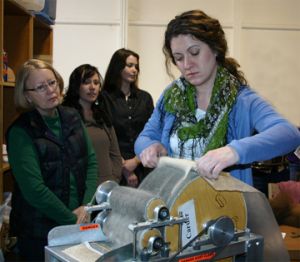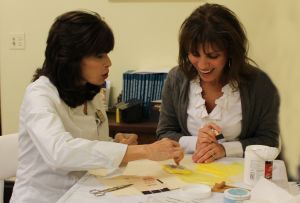After seven rigorous years of self-studies, evaluations and analysis, Saint Mary-of-the-Woods College’s (SMWC) Master of Art Therapy program scored a coveted blue ribbon of excellence–educational approval from the American Art Therapy Association (AATA). Thirty-four programs across the nation have made the list, and SMWC took it to the next level by becoming the first distance program in the nation to earn AATA’s revered approval.

“This takes our program into the limelight,” said Master of Art Therapy Director Kathy Gotshall, ATR, LCSW. “It is an acknowledgement of our quality and integrity.” The approval certifies what many already knew: that SMWC’s challenging and inspirational art therapy program creates experienced healthcare professionals, who make a difference in the world the moment they graduate.
AATA is, in many ways, the governing body of art therapy. The organization awards scholarship and grants, advances research, develops standards, promotes awareness and, most importantly, oversees registration for art therapists. Art therapy, as defined by AATA, “is a mental health profession that uses the creative process of art making to improve and enhance the physical, mental and emotional well-being of individuals of all ages.”
“We’ve always met AATA standards,” said Lisa D. Hinz, Ph.D., ATR, adjunct professor of art therapy at The Woods. “Now we just have an official stamp of approval.” Even before AATA’s approval, the art therapy program swelled with a massive influx of students.
“Because this program is so unique, and with positive word of mouth, our enrollment has increased 88 percent over the past year,” said Courtney Richey, director of graduate admissions at SMWC.
These numbers, combined with the approval, deliver a strong message to the world, with significant payoffs. Current students can now apply for AATA scholarships. Prospective students apply confidently to a program backed by the very organization with the ultimate power– overseeing education standards.
Most importantly, though, it propels students closer to their primary goal–500 steps closer, to be exact. Once art therapy students earn their master’s degrees, they must complete supervised clinical hours before they can receive their art therapist registration (ATR). Without AATA approval, graduates must take on 1500 hours. With this approval, graduates gain registration after only 1000 hours. AATA approval validates that SMWC graduates are professionals, who emerge armed with a toolbox filled with well-tested art therapy techniques.

Art therapy deepens cognitive abilities, restores physical well being and soothes psychological trauma by encouraging patients to engage with their experiences in creative, non-linear ways. “You create an image that reflects the inside,” Hinz said. “Patients can show you what their world means to them.” Swirling paint into the shape of a tree develops fine motor control. Pounding clay brings an external release of pent-up emotions. To feel the medium change, to see the art grow into a reflection of yourself flips a switch inside.
For art therapy graduate Tiffany Palmieri, the AATA approval proves that you can learn all these techniques at a distance, which was her biggest selling point when deciding on SMWC. “The distance element is so unique to our program,” she said. “You work with people all over the world who share the same passion. You become a family.”
SMWC’s art therapy master’s program operates in a hybrid format. Almost all coursework is submitted online, but students also meet three times a year on the College’s campus. All the supervised clinical experiences take place near where the student lives. This way they get the best of both worlds: face-to-face collaboration mixed with working from a distance, so they never have to put their lives and careers on hold.
“I was able to keep pursuing my dream,” said Palmieri, who moved all over the country during the program, never hitting a snag. The distance element is more than just a convenience; it is a bridge to extraordinary, and often surprising, connections. From Hong Kong to California, to right here in our own Hoosier country, art therapy graduates emerge from The Woods connected to people with different experiences, cultures and beliefs. This kind of diversity is the very exposure art therapists need to tailor their methods to each individual.
AATA’s approval illustrates the program’s earnest emphasis on art and in depth focus on clinical therapy. “The professors are great and the curriculum is well-prepared,” said Palmieri, who is diligently plugging away on her internship hours at Barium Springs Home for Children in Statesville, N.C. She is thrilled about the approval, not just for the decrease in her registration hours, but also for the program’s heightened status.
The AATA approval confirms that SMWC can deliver a stellar art therapy education at a distance. “The program was life-changing,” said Knight, who believes she grew into who she was meant to become, both personally and professionally, in the program.
“The staff was amazingly supportive,” she said. “They personalized everything. You can’t get that at a big school.”